| |
|
Bishop's
chapel, North Elmham
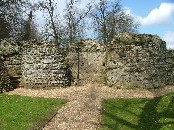 |
|
Christianity
first reached what we now call East Anglia with
Roman soldiers in the 3rd or 4th century - there
are remains of what appears to be a church at
Colchester - but when the Romans went home the
Faith went with them. When the Saxons came and
established the Kingdom of East Anglia, they were
Pagans; but the Wuffings, the East Anglian royal
family, embraced Christianity in the first
quarter of the seventh century. This seems to
have been partly an attempt to build trade links
with the continent. At the time, Ipswich was one
of the largest towns in northern Europe, and King
Redwald was a wily character who, despite his
baptism, eventually received a pagan burial at
Sutton Hoo in the hills above the Deben. But
Redwald's son Seigbert was more committed, and
invited St Felix from Burgundy to evangelise the
Kingdom. |
| Felix
is generally acclaimed as the first Bishop of
East Anglia, and he established his see at
Dummoc, the modern Walton, not far
from the royal palace at Rendlesham and the main
population centres in and around Ipswich. Soon,
the faith had spread, the East Anglians receiving
it enthusiastically. Other missions became
involved; that of St Botolph at Iken, and St
Fursey at Burgh Castle. And then,
the Vikings came, and the Kingdom was reduced to
anarchy. The See seems to have lapsed, but by the
middle of the 10th century we find the Bishops of
East Anglia re-established, with a Cathedral here
in the intensely rural valley of the Wensum.
|
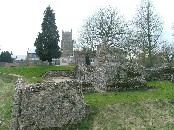 |
|
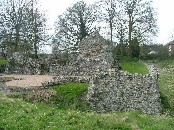 |
|
Descriptions
of their cathedral survive from a couple of
centuries later; it seems to have been a wooden
building, a stockade as much as a place of
worship, and after the Norman invasion it was
seen as both inadequate and too remote, by a
Church authority that wanted to centralise power.
The see moved to Thetford, at the heart of the
Breckland, by now East Anglia's most populous
area. There was an attempt to move it further, to
Bury St Edmunds, by now the principal town of the
region, but this was rejected by the monks of
Bury Abbey, who did not want to be drawn under
English jurisdiction. And so in 1094 it moved to
Norwich, by no means a major centre at the time,
but close to the great castle and with links to
the continent. Today, both Bishops of East
Anglia, Catholic and Protestant, still have their
Cathedrals in Norwich, which has become the
largest city in the region. |
| And
that might have been the end of the story; but
the Bishops retained land in North Elmham,
possibly even the site of the original cathedral,
and they continued to live here when on retreat
from the Cathedral. So it was that at the start
of the 12th century Herbert de Losinga, Bishop of
East Anglia, built a private chapel to go with
his house here at North Elmham, and these are the
remains that we see today. The picture
is slightly complicated because there are also
remains here of a later building, the late 14th
century manor house of Bishop Hugh Despencer,
which seems to have incorporated the walls of the
earlier chapel.
|
|
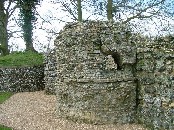 |
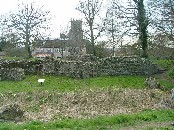 |
|
The
moat dates from Despencer's time, but there is
some evidence that the raised ground to the north
west may once have been the site of a small
Norman castle. The ruined chapel was about
40 metres long, and the outline of the walls seem
to suggest a western tower and an apsed chancel,
with two transepts that may also have supported
towers. The best views are from beyond the moat,
looking down into the ruin, especially from the
east. Norman churches are not a rarity in
Norfolk, but it is interesting to see the bones
of one, as it were, and to extricate the chapel
from the later house. Wandering in the ruins
themselves can be confusing, because the
amalgamation of the two buildings has created
some unexpected doorways and dead ends.
|
| For
a number of years, the ruin was advertised as
actually being of the Saxon cathedral; but there
are no Saxon remains here, and the signs which
suggested that there were have been removed.
English Heritage, who don't often get
complimented on this website, have also stopped
charging an entrance fee, for which they are to
be commended. Of itself, this is not a
particularly atmospheric ruin, but the setting is
super. On a sunny day it is a lovely spot,
especially in spring, when you can hear the
clamour of the new-born lambs in the fields
around, and the excited birds in the air above.
If the clock strikes in the great tower of the
nearby parish church, then you will feel yourself
to be somewhere deeply rural, profoundly English,
and all the more fortunate for the experience. |
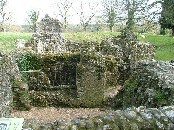 |
|
Simon Knott, May 2006
|
|
|
